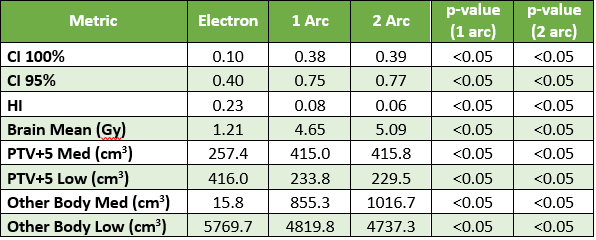Dosimetric comparison between VMAT and electron treatments for skin cancers of the head and neck
Jack Ashman,
United Kingdom
PO-1512
Abstract
Dosimetric comparison between VMAT and electron treatments for skin cancers of the head and neck
1The Clatterbridge Cancer Centre, Physics, Liverpool, United Kingdom
Show Affiliations
Hide Affiliations
Purpose or Objective
Electron radiotherapy is a
frequently used treatment for skin cancers due to the high surface dose and
sharp dose fall off beyond Dmax sparing healthy tissue beyond the target. At our
centre, the electron service is resource intensive due to the limited number of
trained staff and the additional quality assurance (QA) required. Brachytherapy and kV x-rays are alternative treatment methods, but come with their limitations. Low energy x-rays incident on materials of different density, such as the skull and tissue, will result in a perturbed dose. Brachytherapy is even more
resource intensive than electron treatments due to the extensive patient
moulds and immobilisation required. Volumetric Modulated Arc Therapy (VMAT)
is widely used in our center and staff are familiar with the planning
processes. If skin cancers were to be treated with VMAT then there would be
reduced QA and an increase in the staff able to plan. It is hypothesised that
VMAT will improve dose conformity and homogeneity of the PTV whilst being more
resilient to patient contour.
Material and Methods
Ten skin cancer patients
originally planned with electrons were re-planned using a 6MV
flattening filter free (FFF) VMAT beam. A 1 arc and 2 arc plan were generated. Five of the ten patients had scalp/forehead
cancers while the other five had a facial cancers including nose, cheek and
lip. If required, planning bolus of thickness 0.6cm was added to the skin
surface around the PTV to ensure coverage. A PTV+5cm and an
additional Other Body structure were created to assess the dose to normal
tissue up to 5cm beyond the PTV and all other normal tissue beyond the PTV+5cm structure respectively.
Organs at risk (OARs) were contoured and the plans were optimised. The
homogeneity index (HI) and the 90%, 95% and 100% dose conformity indices (CI) of the PTV were evaluated. The volume of PTV+5cm and Other Body receiving a low (<5% of prescription),
intermediate (between 5 and 50% of prescription) and high (>50% of prescription) dose were analysed.
Results
Below are tables showing only the
significant dosimetric differences between the 1 arc, 2 arc and electron plans.
Table 1:
Dosimetric comparison of a 1 arc and 2 arc plan with an electron plan.

Table 2:
Dosimetric comparison between the 1 arc and 2 arc plan.

Conclusion
This study showed that using VMAT in place of electrons provides a greater 95% and 100% PTV conformity for skin cancers of the head and
neck but no significant change in the 90% CI. As expected,
this comes at the cost of an increased mean dose to the brain and an increased
low and intermediate dose to normal tissue beyond the PTV. A 2 arc plan
provides better conformity of the PTV than the 1 arc plan, but again is at the cost of an increased
intermediate dose to normal tissue. The clinical impact of the low dose bath is
not yet widely understood. Additional work may focus on further optimising the
VMAT plans to reduce the low dose bath effect and analyse the dose reported to
critical OARs.